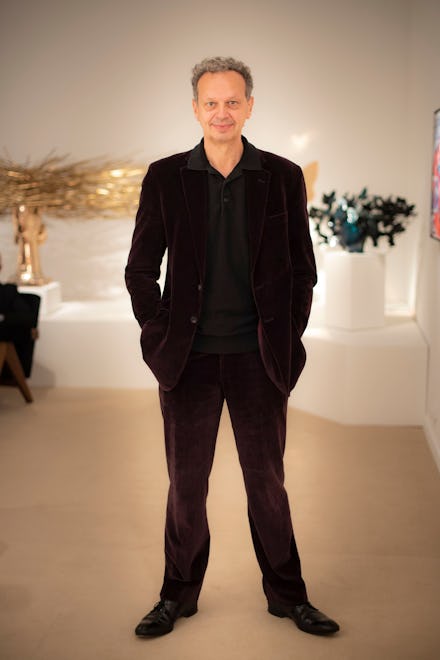Designer Tom Dixon's creations are made for all the senses

Tom Dixon is known for making home goods that captivate your attention carefully. The self-taught designer's signature brand is an emporium of sensation. Candles that tingle but never burden, lights that dazzle only when they need to, furniture that seduces. Alongside chef Assaf Granit, he owns the restaurant Coal Office, in London, where the sensory exploration continues — Coal Office serves an array of Mediterranean style dishes.
Recently, Dixon's brand launched its TOUCHYSMELLYFEELYNOISYTASTY installation, which debuted at the London Design Festival in September, at its New York storefront. A selection of objects intended to engage with our most animalistic instincts — our sense of smell, taste, hearing, and touch — the installation included a great deal of collaboration. The 60-year-old designer enlisted a range of brands, like Harry’s razors, Cocoon Tea, and the Swedish synthesizer company Teenage Engineering, to create a slate of items for 2020.
"The thing that I learned is that in our modern world a brand is not a thing you need to defend," Dixon said on a recent afternoon in New York City. "A brand is really a sum of its networks."
I talked to Dixon about his new collection, how he thinks design can tackle questions of sustainability, and what it might take for people to get out of their phones and into the real world.
You seem to be focused on design as an experience for the customer. What inspired you to consider smells and the texture as opposed to just the aesthetic of an object?
I was thinking a lot about the modern world and how more and more, people experience things in two dimensions through their phones. And then I thought about things that were not digitizable, like smells. Even sound — which you do digitalize now on these miniature devices, but you're don’t get what used to get, you used to get the sound to your guts. I think everything's become kind of thin and two dimensional. Our battle is how the hell do you get people to come to your place and experience something.
I often see the design world concentrating on just the visual aspect. People are multisensory animals, right? I’m busy retraining myself to be a bit more animalistic, basically, and using more aspects of the skill sets that you've got by just heightening the senses. It's ended up with lots of new conversations with new partners and people that come from other trades.
How do you approach all of the different combinations of senses?
I think about lighting, because of how it affects the environment that you live in. It’s kind of great because you can transform a mood very quickly. We try to make things that are functional but still look interesting, since they don't need to be on in the daytime. So all of these things have to do with the domestic environment or your work environment, all become part of a bigger interior design piece, which goes beyond making a mood board and thinking of shapes and stuff like that. It gets into how we behave as people. It's easy sometimes to kind of forget about it because you're spending your whole time on the phone. This is kind of a dangerous thing for a human being. It means that you're forgetting about your other abilities as a creature. It's like this whole thing of taking a picture of your food before you taste it. So we're kind of interested in how you can attract people back to engaging with the senses. How do you get people to really experience the real world again?
I think everything's become kind of thin and two dimensional. Our battle is how the hell do you get people to come to your place and experience something.
In the time that you've been working, you've experienced technology grow in real time. How has that affected your practice?
Well, I think I'm lucky in as much as I do know the world before the internet dominated everything. So I'm able to look at it as an outsider and really appreciate it for it’s potential and possibilities and future, but see it as something that you have to balance with with the things that are just as important. I think that balance is the most important thing in the world.
When it does come to products, what kinds of considerations do you make as a designer in terms of sustainability?
The number one consideration just building things durably. There's a lot greenwashing going around right now. So you know, people want to talk about sustainability. But the reality is that we're all engaged in selling things that people don't necessarily need, right? So proper sustainability comes from not producing stuff I at all. But if you're going to produce stuff, then you'd better damn well make sure that the thing is going to stick around for awhile. But I guess in a way, we’re kind of lucky in terms of the field that we occupy is where people really don't buy items like this more than once every 20 years.
If you're lucky, then you've got your great grandmother's couch, which has been there for 20 years. Right? So if we get it right, we build the things not to be too fashionable and to be made out of the materials that you can maintain and that you make so high standard that the shit is going to stick around. And then the rest of it is all of the office stuff like, how can you cut down on transport? How can you cut down on wasted production? How can you make sure the materials you're using creatively and in the right way.